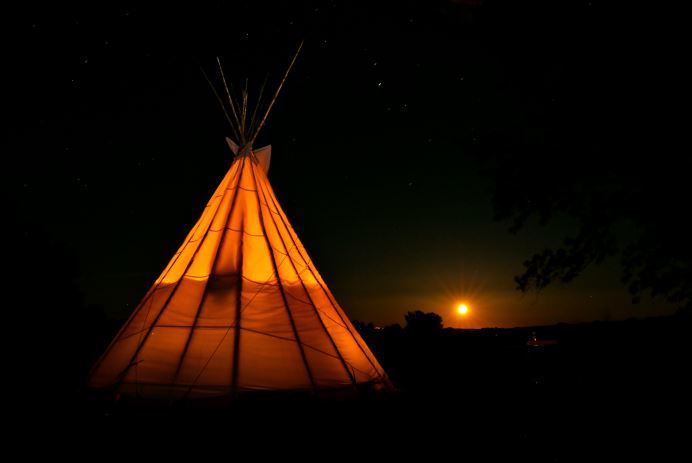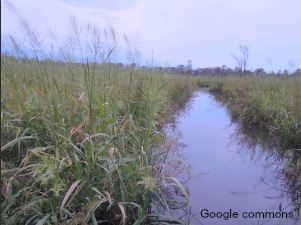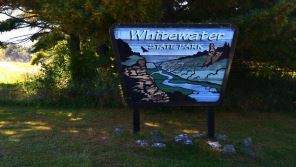Traveler - Preserving Indigenous Peoples' Stories
Minnesota State Parks and Trails
Traveler
October 2017

Upper Sioux Agency State Park
On October 10, 2016, Governor Mark Dayton made a proclamation recognizing the second Monday in October as Indigenous Peoples Day in Minnesota. The proclamation was made on behalf of the State of Minnesota in order to "promote appreciation, tolerance, reconciliation, understanding, friendship, and continued partnerships among all of its people and the Indigenous Peoples of this land." Read the proclamation.
In honor of Indigenous Peoples Day, the October 2017 issue of the Traveler introduces you to sites within our state parks and trails system that strive to interpret the stories of Indigenous Peoples in Minnesota. One such site, Upper Sioux Agency State Park, was established in 1963 to preserve and interpret the remains of the former Yellow Medicine Agency site which was destroyed in the U.S.-Dakota War of 1862. The park covers 1,280 acres and offers diversity: open prairie knolls, bluffs, and cool, wooded slopes. From the vistas, visitors enjoy the trails which are ideal for horseback riding, hiking, skiing, and snowmobiling. The park also offers a huge sliding hill for winter fun. Tipi camping at Upper Sioux Agency State Park was named "Best Camping with a Twist" in the Star Tribune's 2014 Best of Minnesota review!
- Find maps, directions and other park information about Upper Sioux Agency State Park.
- See the beautiful sights of the park with this virtual tour.
The List - Interpreting Indigenous Cultures 
The stories of Indigenous Peoples are found at every state park in Minnesota. Many state parks provide interpretation of their site history prior to European contact, offering programs and events that reflect on the stories, skills and ingenuity of early cultures in the land that would later be called Minnesota.
Upper Sioux Agency State Park provides a variety of programs and events to teach about the history of the Dakota in the area. Other parks you may want to visit to learn more about Indigenous Peoples in Minnesota include:
- Blue Mounds State Park, near Luverne, which uses their herd of 100 bison to tell the story of the Plains Indians’ dependency on the bison to survive.
- Crow Wing State Park near Brainerd, which was the scene of a major battle between the Dakota and Ojibwe in 1768.
- Fort Snelling State Park, in St. Paul, which was an important location during the U.S.-Dakota War of 1862.
- Grand Portage State Park, located within the Grand Portage Indian Reservation in Grand Portage, MN, and the only state park not owned by the State of Minnesota.
- Mille Lacs Kathio State Park, in Onamia, that provides interpretation on the 9,000 years of human history at the site.
Visit state park websites to discover more about American Indian culture and history in Minnesota .
Discover - What's in a Name?
|
Learn more stories behind the names of towns, cities and locations throughout Minnesota.
Nature Sightings - Wild Rice
If you get out paddling on one of Minnesota's 10,000-plus lakes this fall, keep an eye out for wild rice. Typically growing in shallow water depths of one to three feet, mature wild rice beds look like stands of tall, fluffy grass. These rice beds are very attractive to migrating birds including red-winged blackbirds and many species of ducks.
Minnesota has more acres of natural wild rice than any other state in the country. Wild rice has been historically documented in 45 of Minnesota's 87 counties and in all corners of the state. Anecdotal information suggests an even broader distribution prior to European settlement.
Wild rice is an important social and cultural component for American Indian tribes and rural Minnesota communities. Ricing takes place from mid-August through September. During the month of October, Ojibwe communities tend to drying, parching and preparing the rice before it can be packaged for later use or to sell.
Wild rice is affected by water flow, turbidity, water quality and water level fluctuations. Wild rice is sensitive to varying water levels, and production in individual stands from year-to-year is highly variable depending on local water conditions.
Learn more about the seasonal traditions of the Ojibwe in Minnesota.
Peddle Into the Past
Whether we hike, peddle or paddle, we gain different perspectives about a place by the way we choose to traverse the landscape. State Trails allow visitors to immerse themselves in the beauty and diversity of Minnesota’s natural landscapes while observing a glimpse of the past. As you peddle our many different trails, you pass through remnant and restored ecosystems of days gone by. From the prairies, wetlands and potholes found along the Central Lakes State Trail to the dramatic North Shore scenery along the Gitchi Gami State Trail and to the deeply carved limestone valleys that cradle the Root River State Trail, you can experience the uniqueness of each ecological region while pondering the connections between the plants and animals that evolved here and the people who called Minnesota home long before Europeans arrived.
Learn more about our state trails.
October Programs and Events
|
Find more naturalist programs.
Keep reading! For past issues of the Traveler, click here.





